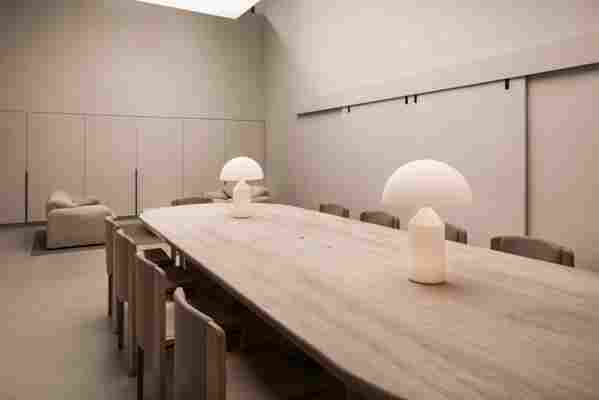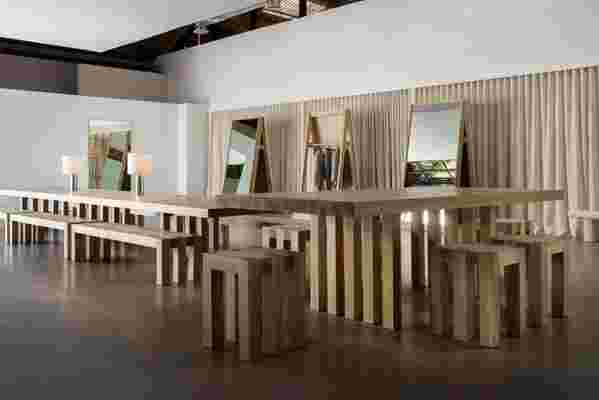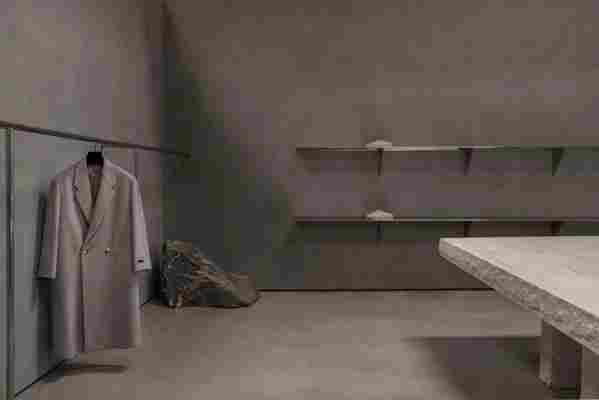Inside Fear of God's Starkly Sensual New Downtown Los Angeles HQ
Growing up, fashion designer Jerry Lorenzo’s father Jerry was an MLB coach and manager—for the White Sox and the Mets, among others—and instilled in him a reverence for teamwork. Today, it’s a guiding principle for how he runs his luxurious yet laid-back clothing label Fear of God . So, when Lorenzo, 44, was renovating his combined office, studio, and showroom—an airy loft located near the Arts District in downtown Los Angeles—he sought to create a space that fostered collaboration and open dialogue.
“I’m always thinking about the team and how we create an environment that brings the best out of everyone,” Lorenzo said one recent gray morning. “A place where the team can clearly see each other and work together, hold each other accountable.”

A meeting room is anchored by a large wooden table. “We wanted everything living honestly in its own form,” Lorenzo said. “The table isn’t painted, you know? Everything is honest to its purpose and nature of being.”
To help create the austere, airy design studio and offices, Lorenzo brought in a pair of talents to transform the structure, Relativity Architects who tackled the project's overall overhaul, along with polymathic creative director and designer Willo Perron whose studio, Perron-Roettinger , handled the furniture and finishings. Perron is well known to aesthetes and brand builders for his myriad of high-profile projects—everything from designing the stores for American Apparel and Stussy to overseeing immersive, concert experiences for Drake, Kanye West, and Rihanna, among others.
Lorenzo is, of course, in the apparel business, and that’s ultimately a business of appearances. On this front, the studio delivers. To enter the building, just beyond an unassuming black façade off a busy thoroughfare, is to be met with vast, creamy, gray walls and striking, oversized furniture, all under monumental light boxes that cast everything in a pleasing glow; above it all is a bowstring truss wood ceiling. “I wanted a place that’s inspirational, that’s beautiful, that’s considered,” said Lorenzo, who established Fear of God in 2012. In some ways, the nearly 10,000 square-foot studio mirrors his clothing—elegant but clean, considered but unfussy.

Lorenzo’s office features a wooden table large enough to host his team for fittings or meetings. “I’m always thinking about the team and how do we create an environment that brings the best out of everyone.”
Perron, who met Lorenzo through Kanye West, said he used the designer’s previous look books and ads as a starting off point for his aesthetic journey. “Jerry has a concise color and material palette,” said Perron, who custom-designed most of the loft's furniture. “He wanted to stay in the desert palette with a little nod to industrial.” In the reception area, to the left when you enter, that translates into a curvilinear cement desk in front of two beige linen couches facing one another, separated by rough-edged stone tables.
Adjacent to the reception is the showroom, which Perron says is the most “dramatic” area in the office. Against a dark gray backdrop sits an imposing travertine table, while stainless steel racks and shelves line the walls, upon which the current collection sits. Large stones in the corner lend the room a touch of gravitas and conjure the arid desert landscape that Lorenzo likes. “He likes that drama,” Perron says.

The showroom, where the current collection is on display. “Jerry likes drama,” Perron said, noting the scale of furniture and rooms—plus the overhead light boxes—helps to create arresting tableaux with minimal objects.
The design studio and office spaces tend toward a mix of zen-like minimalism and stark brutalism: Open rooms in soothing neutral tones are often punctuated by a single, dominating piece of furniture—a smooth-edged, light wood table in a meeting room, topped with two glowing lamps, say, or a sharp-angled stainless steel table with matching stools where the design team meets. “Everything is like one idea,” Lorenzo said. “One big table, one mirror. Not a thousand ideas, just one, and it’s the best one.”
Perron puts it this way: “I really believe that you can make a tomato salad with just like really good tomatoes, and, like, some salt and some oil. That’s it, you know?”
Jerry Lorenzo
The reception area features an organic concrete desk framed by two couches and raw-edged stone tables. “We liked the idea of landscapes and the singularity of materials,” Perron said, noting there are no mixed-material furniture pieces in the office.
One thing Lorenzo points out is the way the walls don’t meet the roof, so that there’s a delineation of different areas, but you can still feel the energy from a room—or three—over. “I like that you can kind of feel something’s happening next door,” he said. “It’s like a little city, like there’s music over here, people working over there. And that’s why the showroom is in the middle, so our guests can feel the love and energy and get a sense of what’s happening. It’s like Willy Wonka’s workshop.”
And while some designers surround themselves with a surfeit of visual ephemera to help inspire them (think Karl Lagerfeld’s overstuffed bookshelves ), Lorenzo’s office is quite bare—a blank canvas. “I love anything that’s perfectly un-opinionated,” he says. “I wanted a place that’s tranquil. The less opinions I have around me, the easier it is to work.”
“I really like the contrast of things that are really glossy next to things that are really muted,” Perron said. Here, a stainless steel desk and stools sits in front of linen boards where design sketches and images can be pinned.